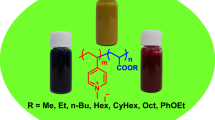Abstract
Three alkyltrimethylammonium bromides (i.e., dodecyl-, tetradecyl-, and hexadecyltrimethylammonium bromide or DTAB, TTAB, and CTAB, respectively) were used to remove a blue solvent-based ink from a printed surface of high-density polyethylene bottles. Either an increase in the alkyl chain length or the surfactant concentration was found to increase the deinking efficiency. Complete deinking was achieved at concentrations about 3, 8, and 24 times of the critical micelle concentration (CMC) of CTAB, TTAB, and DTAB, respectively. For CTAB, ink removal started at a concentration close to or less than its CMC and increased appreciably at concentrations greater than its CMC, while for TTAB and DTAB, significant deinking was only achieved at concentrations much greater than their CMCs. Corresponding to the deinking efficiency of CTAB in the CMC region, the zeta potential of ink particles was found to increase with increasing alkyl chain length and concentration of the surfactants, which later leveled off at some higher concentrations. Wettability of the surfactants on an ink surface increased with increasing alkyl chain length and concentration of the surfactants. Lastly, solubilization of ink binder in the surfactant micelles was found to increase with increasing alkyl chain length and surfactant concentration. We conclude that adsorption of surfactant on the ink pigment is crucial to deinking due to modification of wettability, zeta potential, pigment/water interfacial tension, and dispersion stability. Solubilization of binder (epoxy) into micelles is necessary for good deinking because the dissolution of the binder is required before the pigment particles can be released from the polymer surface.











Similar content being viewed by others
References
Michaeli W, Dassow J (1994) SPE-ANTEC Proc 2994
Manrich S (2000) Polym Recycl 5:213
Gecol H, Scamehorn JF, Christian SD, Grady BP, Riddell FE (2001) Colloids Surf A Physicochem Eng Asp 189:55
Eltanany G, Tipton RJ, Teeters D (2001) Mater Res Innov 4:166
Gecol H, Scamehorn JF, Christian SD, Grady BP, Riddell FE (2002) J Surfactants Deterg 5:363
Songsiri D, Min SS, Scamehorn JF, Osuwan S, Ellis JW (2002) Colloids Surf A Physicochem Eng Asp 204:261
Gecol H, Scamehorn JF, Christian SD, Riddell FE (2003) Colloid Polym Sci 281:1172
Scamehorn JF, Harwell JH (eds) (1989) Surfactant-based separation processes. Dekker, New York, p 255
Scamehorn JF, Harwell JH (eds) (2000) Surfactant-based separations: science and technology. ACS symposium series, vol 740. American Chemical Society, Washington, DC
Leach RH, Pierce R (eds) (1999) The printing ink manual, 5th edn. Springer, Berlin Heidelberg New York
Mark HF, Bikales N, Overberger CG, Menges G, Kroschwitz JI (eds) (1988) Encyclopedia of polymer science and engineering, vol 13. Wiley, New York
Lee H (1981) Handbook of epoxy resins. McGraw-Hill, New York
Ballasuwatthi P, Dechalbumphen N, Saiwan C, Scamehorn JF (2004) J Surfactants Deterg 7:31
Jönsson B, Lindman B, Holmberg K, Kronberg B (1999) Surfactants and polymers in aqueous solution. Wiley, London (chap 9)
Klevens HB (1948) J Phys Colloid Chem 52:130
Lianos P, Zana R (1982) J Colloid Interface Sci 88:549
Czerniawski M (1966) Rocz Chem 40:1935
Adamson AW, Gast AP (1997) Physical chemistry of surfaces, 6th edn. Wiley, New York (chap 10)
Rosen MJ (2004) Surfactants and interfacial phenomena, 3rd edn. Wiley, New York (chap 6)
Okuzaki H, Osada Y (1994) Macromolecules 27:502
Biswas SC, Chattoraj DK (1997) Langmuir 13:4505
Shah SS, Khan MS, Ullah H, Awan MA (1997) J Colloid Interface Sci 186:382
Swanson-Vethamuthu M, Almgren M, Karlsson G (1996) Langmuir 12:2173
Rosen MJ (2004) Surfactants and interfacial phenomena, 3rd edn. Wiley, New York (chap 3)
Scamehorn JF, Harwell JH (1993) In: Ogino K, Abe M (eds) Mixed surfactant systems. Dekker, New York, p 283
Karsa DR (2000) Surface active behavior of performance surfactants, 1st edn. Sheffield, Manchester, p 105
Chandar P, Somasundaran P, Turro NJ (1988) Macromolecules 21:950
De Oliveira VA, Tiera MJ, Neumann MG (1996) Langmuir 12:607
Porter MR (1994) Handbook of surfactants, 2nd edn. Blackie, New York, pp 50–57
Acknowledgements
Funding was provided by the Petroleum and Petrochemical Technology Consortium (through a Thai governmental loan from the Asian Development Bank), Chulalongkorn University (through a grant from the Ratchadapisek Somphot Endowment Fund for the Foundation of the Applied Surfactants for Separation and Pollution Control Research Unit), and the Petroleum and Petrochemical College, Chulalongkorn University. Funding was also provided by the industrial sponsors of the Institute for Applied Surfactant Research at the University of Oklahoma, including Akzo Nobel, Clorox, Conoco/Phillips, Church and Dwight, Ecolab, Halliburton, Huntsman, Oxiteno, Procter & Gamble, Sasol, Shell Chemical, and Unilever. Special appreciation goes to Uni Ink Co. for supplying blue solvent-based ink formulation, Winson Screen Co. for technical assistance with the printing technique, and P-Thai Co. for printing the as-received ink on HDPE bottles.
Author information
Authors and Affiliations
Corresponding author
Rights and permissions
About this article
Cite this article
Chotipong, A., Scamehorn, J.F., Rirksomboon, T. et al. Removal of solvent-based ink from printed surface of HDPE bottles by alkyltrimethylammonium bromides: effects of surfactant concentration and alkyl chain length. Colloid Polym Sci 284, 980–989 (2006). https://doi.org/10.1007/s00396-005-1421-3
Received:
Accepted:
Published:
Issue Date:
DOI: https://doi.org/10.1007/s00396-005-1421-3




